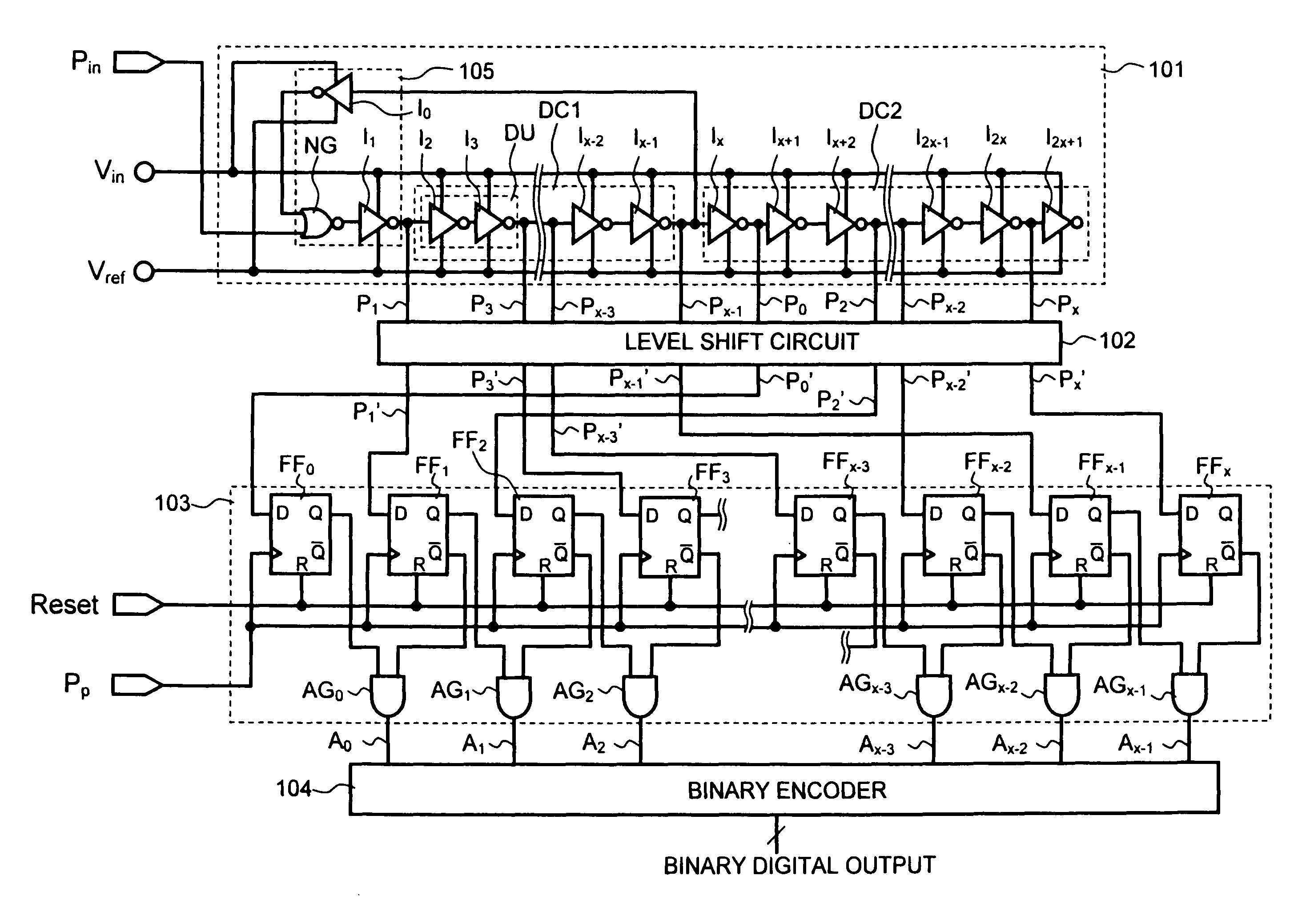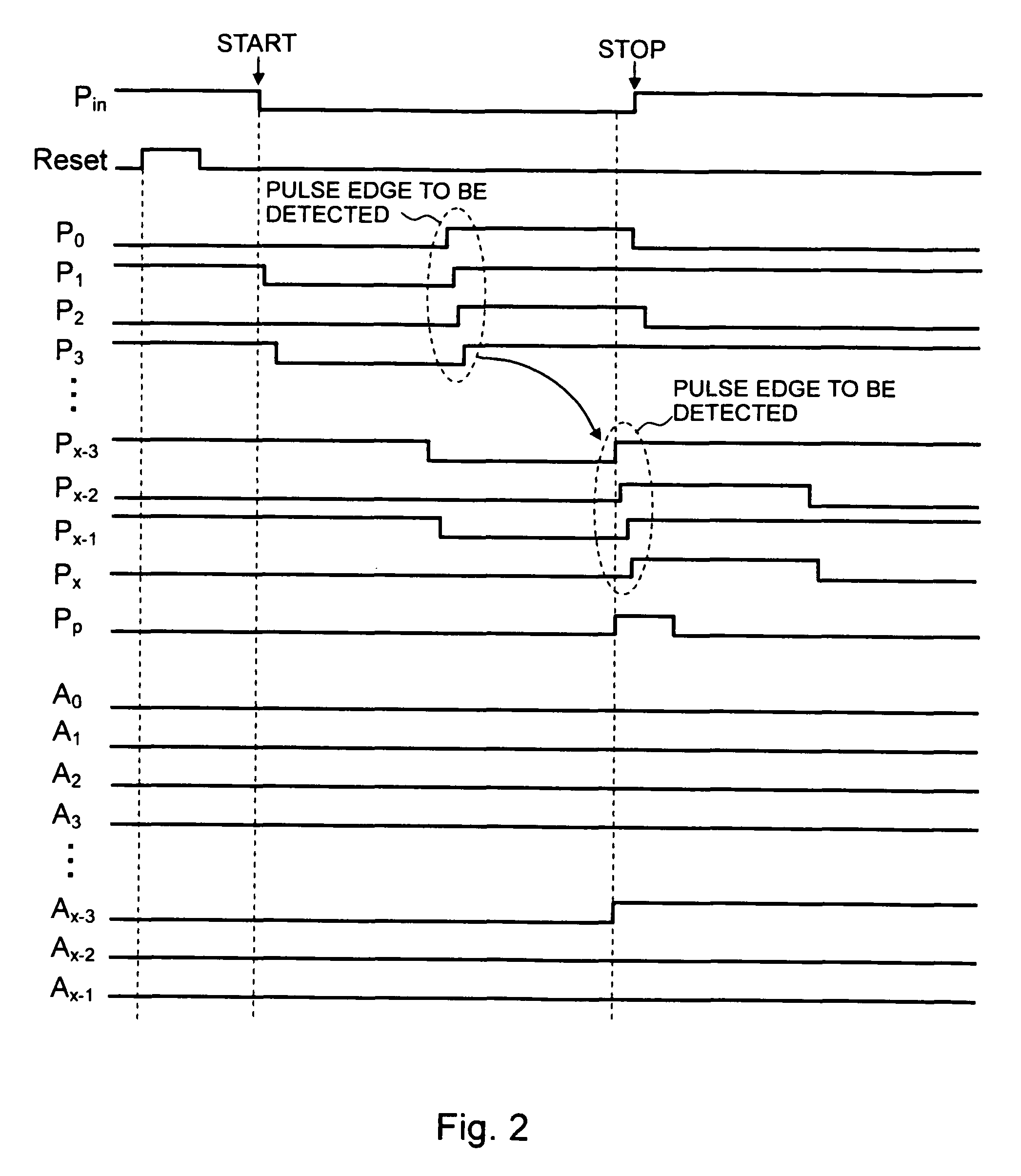Pulse phase difference detecting circuit and A/D converter using the same
a phase difference detection and converter technology, applied in pulse automatic control, code conversion, instruments, etc., can solve the problems of delay amount, layout placement, and limitation of design degree of freedom, so as to reduce the sampling time of adc, high speed operation, and high resolution
- Summary
- Abstract
- Description
- Claims
- Application Information
AI Technical Summary
Benefits of technology
Problems solved by technology
Method used
Image
Examples
first exemplary embodiment
[0035]Exemplary embodiments of the present invention will be described below with reference to the accompanying drawings. FIG. 1 is a circuit diagram showing an ADC using a pulse phase difference detecting circuit according to a first exemplary embodiment of the present invention. As shown in FIG. 1, the ADC according to the first exemplary embodiment includes a pulse phase difference detecting circuit 101, a level shift circuit 102, a pulse edge detecting circuit 103, and a binary encoder 104.
[0036]Referring to FIG. 1, the pulse phase difference detecting circuit 101 includes a NOR gate NG and (2x+2) number of inverters I0, I1, I2, I3, . . . , Ix−2, Ix−1, Ix, Ix+1, Ix+2, I2x−1, I2x, and I2x+1. Inverters I4 to Ix−3 and inverters Ix+3 to I2x−2 are omitted in FIG. 1. In this case, assuming that the ADC has a resolution of n bits, “x” is expressed as x=2n. Each of the inverters operates at a voltage between a reference voltage Vref and an input voltage Vin. For example, when the refere...
second exemplary embodiment
[0057]Next, another exemplary embodiment of the present invention will be described. FIG. 4 is a circuit diagram showing an ADC according to a second exemplary embodiment of the present invention. Components identical with those of the first exemplary embodiment are denoted by the same reference symbols, and description thereof is omitted as appropriate. As shown in FIG. 4, the ADC according to the second exemplary embodiment includes a pulse edge detecting circuit 203 including NOR gates in replace of the AND gates shown in FIG. 1. The other components are similar to those of the first exemplary embodiment.
[0058]A NOR gate NG0 receives a signal output from the output terminal Q of the D flip-flop FF0, and a signal output from the output terminal Q of the D flip-flop FF1. A NOR gate NG1 receives a signal obtained by inverting a signal output from the output terminal Q of the D flip-flop FF1 by an inverter, and a signal output from the output terminal Q of the D flip-flop FF2. Likewi...
third exemplary embodiment
[0061]Next, still another exemplary embodiment of the present invention will be described. FIG. 5 is a circuit diagram showing a pulse phase difference detecting circuit according to a third exemplary embodiment of the present invention. FIG. 6 is a block diagram showing an ADC using the pulse phase difference detecting circuit according to the third exemplary embodiment. Components identical with those of the first exemplary embodiment are denoted by the same reference symbols, and description thereof is omitted as appropriate.
[0062]When the inverters constituting the pulse phase difference detecting circuit 101 according to the first and second exemplary embodiments are used to operate at a voltage close to a threshold voltage Vth of a CMOS transistor, a delay variation due to a change in voltage increases. This increases the total delay amount of delay units and the sampling time of the ADC, which makes it difficult to perform a high-speed operation. In addition, transistor opera...
PUM
 Login to View More
Login to View More Abstract
Description
Claims
Application Information
 Login to View More
Login to View More - R&D
- Intellectual Property
- Life Sciences
- Materials
- Tech Scout
- Unparalleled Data Quality
- Higher Quality Content
- 60% Fewer Hallucinations
Browse by: Latest US Patents, China's latest patents, Technical Efficacy Thesaurus, Application Domain, Technology Topic, Popular Technical Reports.
© 2025 PatSnap. All rights reserved.Legal|Privacy policy|Modern Slavery Act Transparency Statement|Sitemap|About US| Contact US: help@patsnap.com



